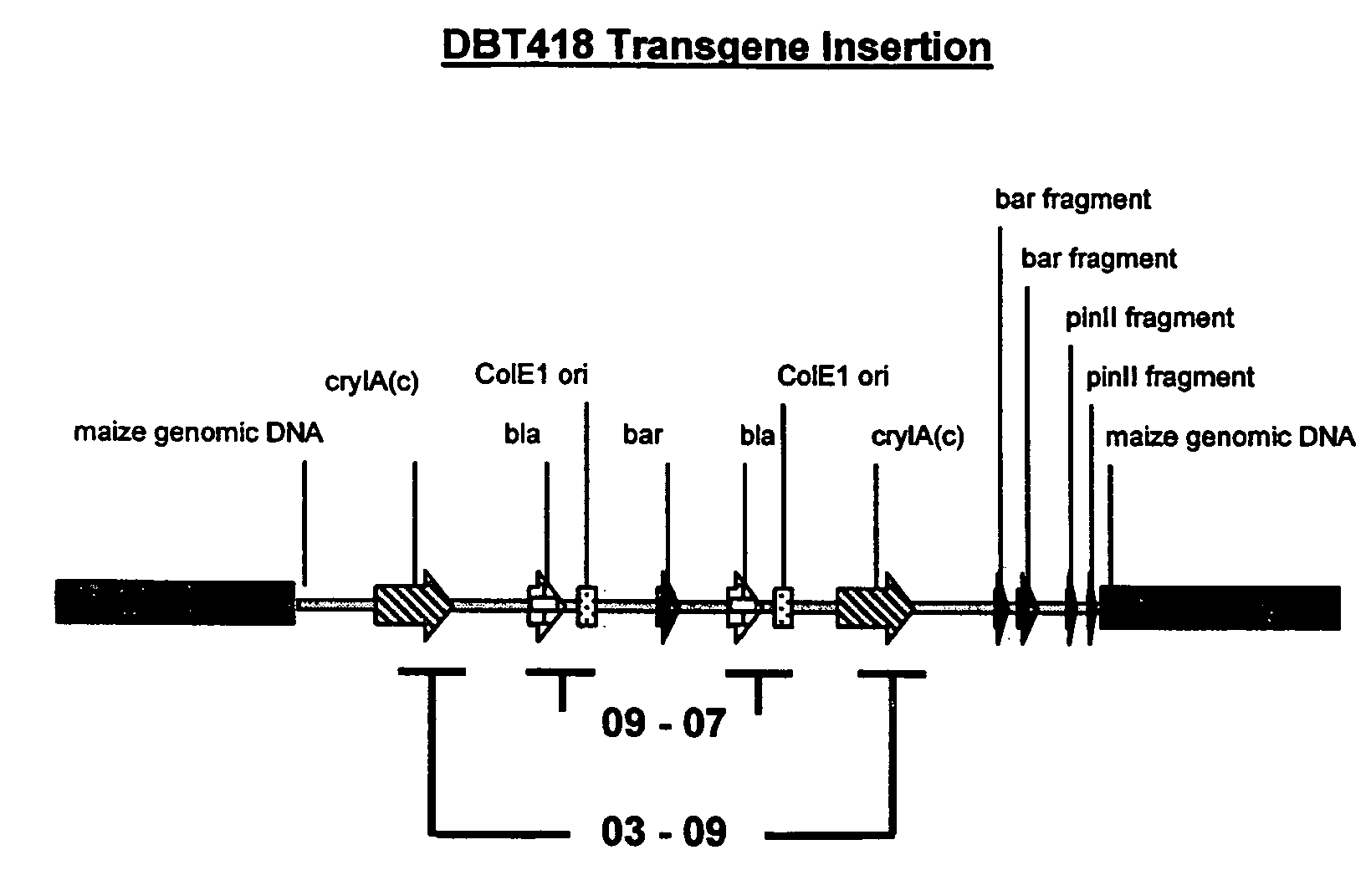Homologous recombination mediated transgene deletion in plant cells
a plant cell and homologous recombination technology, applied in the field of transgenic cell production methods, to achieve the effect of decreasing the occurrence of co-suppression and increasing the stability of the transgen
- Summary
- Abstract
- Description
- Claims
- Application Information
AI Technical Summary
Benefits of technology
Problems solved by technology
Method used
Image
Examples
example 1
Deletion of the Bar Gene from the Transgenic Event DBT418
[0329]Homologous recombination-mediated transgene deletion is a process whereby the structure of a transgene insert can be altered (see FIG. 1). The process is dependent on the presence of direct repeats of DNA sequences in the transgene insertion. Direct repeats may be present in the transgene used for transformation, or they may arise through multi-element integration at the site of transgene insertion. The direct repeats might be, for example, incomplete parts of a transgene that, upon recombination, produce a complete transgene conferring an identifiable phenotype.
[0330]Line DBT418 was produced by microprojectile bombardment of embryogenic cells with plasmid vectors pDPG354 (FIG. 6), pDPG165 (FIG. 7) and pDPG320 (FIG. 8). The structure of the transgene insert in the line DBT418 is diagramed in FIG. 9 and described in detail in U.S.D.A. Petition 9629101p for deregulation. The insert has one functional copy of a bar gene con...
example 2
Deletion of nptII or cryIA (b) Gene from the Transgenic Events “MON849” and “MON850”
[0335]Transformation events (MON849) and (MON 850) were produced by microprojectile bombardment of cells with plasmid vector using pMON19344 (FIG. 4). The structure of the MON849 transgene insert is diagramed in FIG. 11. The insert has one copy of an nptII gene conferring resistance to kanamycin and one copy of a cryIA(b) Bt gene conferring resistance to certain insect pests. Both the nptII and cryIA(b) coding regions are flanked on the 5′ ends by identical 35S promoters and hsp70 introns. Both the nptII and cryIA(b) coding regions are flanked on the 3′ ends by identical nos terminators. Recombination events between the 35S promoter and hsp70 intron regions of the cryIA(b) gene and the 35S promoter and hsp70 intron regions of the nptII gene result in the loss of the cryIA(b) gene (FIG. 11). Recombination events between the nos terminator region of the cryIA(b) gene and the nos terminator region of th...
example 3
Alteration of a Transgene Insertion Event in Transformed Cells
[0341]The plasmid vector pMON36133 (FIG. 12) was constructed wherein a neomycin phosphotransferase II (nptII) gene is flanked on both the 5′ and 3′ ends by direct repeats of sequences derived from the 3′ end of the maize hsp70 intron. The vector further comprises a gene encoding green fluorescent protein (GFP) that lacks a promoter and is not expressed in a plant cell. Deletion of the sequences between the repeated hsp70 sequences produces a transgene wherein the 35S promoter and hsp70 intron are operable linked to the GFP gene and therefore, the GFP protein is expressed.
[0342]The plasmid vector pMON36133 was introduced into Black Mexican Sweet maize cells using microprojectile bombardment. Transformed callus was selected based on resistance to kanamycin conferred by the nptII gene. Sectors of GFP expressing tissues were observed in the transformants, indicating that the nptII gene was deleted, thereby activating expressi...
PUM
| Property | Measurement | Unit |
|---|---|---|
| distance | aaaaa | aaaaa |
| flight path length | aaaaa | aaaaa |
| pressure | aaaaa | aaaaa |
Abstract
Description
Claims
Application Information
 Login to View More
Login to View More - R&D
- Intellectual Property
- Life Sciences
- Materials
- Tech Scout
- Unparalleled Data Quality
- Higher Quality Content
- 60% Fewer Hallucinations
Browse by: Latest US Patents, China's latest patents, Technical Efficacy Thesaurus, Application Domain, Technology Topic, Popular Technical Reports.
© 2025 PatSnap. All rights reserved.Legal|Privacy policy|Modern Slavery Act Transparency Statement|Sitemap|About US| Contact US: help@patsnap.com



